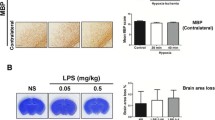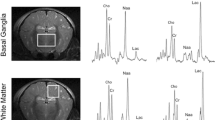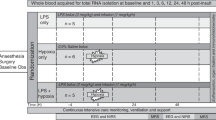Abstract
Neonatal hypoxic–ischemic encephalopathy is the most common cause of neurological disability in infancy. Superimposed inflammation may further worsen neurological outcomes. Reliable biomarkers which are both sensitive to hypoxic-ischemia and inflammation are critically needed. We tested plasma osteopontin (OPN) and glial fibrillary astrocytic protein (GFAP) within the reported therapeutic window (90 min after hypoxic-ischemic (HI) injury) in neonatal rats with different HI severity and inflammation. Two different HI severity groups (mild-HI with 75 min hypoxia and severe-HI with 150 min hypoxia) were established. Inflammation-sensitized HI brain injury induced by lipopolysaccharide (LPS) further increased apoptotic neurons and infarct volumes. In HI alone groups, OPN was significantly decreased (p < 0.001) but GFAP was slightly increased (p < 0.05) at 90 min after HI either in mild-HI or severe-HI compared with naïve group. In LPS-sensitized HI groups, both OPN and GFAP were significantly increased either in LPS-mild-HI or LPS-severe-HI groups compared with the naïve group (all p < 0.05). Induced inflammation by LPS exaggerated neonatal HI brain injury. The plasma OPN and GFAP levels may be useful to differentiate HI alone groups from inflammation-sensitized HI groups or naïve group.





Similar content being viewed by others
Availability of Data and Material (Data Transparency)
All data and materials support the published claims and comply with field standards.
Code Availability (Software Application or Custom Code)
The software application or custom code support their published claims and comply with field standards.
References
Shankaran S, Laptook AR, Ehrenkranz RA, Tyson JE, McDonald SA, Donovan EF, Fanaroff AA, Poole WK, Wright LL, Higgins RD, Finer NN, Carlo WA, Duara S, Oh W, Cotton CM, Stevenson DK, Stoll BJ, Lemons JA, Guillet R, Jobe AH; National Institute of Child Health and Human Development Neonatal Research Network (2005) Whole-body hypothermia for neonates with hypoxic-ischemic encephalopathy. N Engl J Med.353:1574–1584.https://doi.org/10.1056/NEJMcps050929
Douglas-Escobar M, Weiss MD (2015) Hypoxic-ischemic encephalopathy: a review for the clinician. JAMA Pediatr 169:397–403. https://doi.org/10.1001/jamapediatrics.2014.3269
Pin TW, Eldridge B, Galea MP (2009) A review of developmental outcomes of term infants with post-asphyxia neonatal encephalopathy. Eur J Paediatr Neurol 13:224–234. https://doi.org/10.1016/j.ejpn.2008.05.001
Shankaran S, Pappas A, McDonald SA, Vohr BR, Hintz SR, Yolton K, Gustafson KE, Leach TM, Green C, Bara R, Petrie Huitema CM, Ehrenkranz RA, Tyson JE, Das A, Hammond J, Peralta-Carcelen M, Evans PW, Heyne RJ, Wilson-Costello DE, Vaucher YE, Bauer CR, Dusick AM, Adams-Chapman I, Goldstein RF, Guillet R, Papile LA, Higgins RD, Eunice Kennedy Shriver NICHD Neonatal Research Network (2012) Childhood outcomes after hypothermia for neonatal encephalopathy. N Engl J Med 366:2085–2092. https://doi.org/10.1056/NEJMoa1112066
Gluckman PD, Wyatt JS, Azzopardi D, Ballard R, Edwards AD, Ferriero DM, Polin RA, Robertson CM, Thoresen M, Whitelaw A, Gunn AJ (2005) Selective head cooling with mild systemic hypothermia after neonatal encephalopathy: multicenter randomised trial. Lancet 365:663–670. https://doi.org/10.1016/S0140-6736(05)17946-X
Jacobs SE, Berg M, Hunt R, Tarnow-Mordi WO, Inder TE, Davis PG (2003) Cooling for newborns with hypoxic ischaemic encephalopathy. Cochrane Database Syst Rev. https://doi.org/10.1002/14651858.CD003311.pub3
Hagberg H, Gressens P, Mallard C (2012) Inflammation during fetal and neonatal life: implications for neurologic and neuropsychiatric disease in children and adults. Ann Neurol 71:444–457. https://doi.org/10.1002/ana.22620
Hagberg H, Mallard C, Ferriero DM, Vannucci SJ, Levison SW, Vexler ZS, Gressens P (2015) The role of inflammation in perinatal brain injury. Nat Rev Neurol 11:192–208. https://doi.org/10.1038/nrneurol.2015.13
Sävman K, Blennow M, Gustafson K, Tarkowski E, Hagberg H (1998) Cytokine response in cerebrospinal fluid after birth asphyxia. Pediatr Res 43:746–751. https://doi.org/10.1203/00006450-199806000-00006
Bartha AI, Foster-Barber A, Miller SP, Vigneron DB, Glidden DV, Barkovich AJ, Ferriero DM (2004) Neonatal encephalopathy: association of cytokines with MR spectroscopy and outcome. Pediatr Res 56:960–966. https://doi.org/10.1203/01.PDR.0000144819.45689.BB
Mir IN, Johnson-Welch SF, Nelson DB, Brown LS, Rosenfeld CR, Chalak LF (2015) Placental pathology is associated with severity of neonatal encephalopathy and adverse developmental outcomes following hypothermia. Am J Obstet Gynecol 213:849.e1–849.e7. https://doi.org/10.1016/j.ajog.2015.09.072
Parker SJ, Kuzniewicz M, Niki H, Wu YW (2018) Antenatal and intrapartum risk factors for hypoxic-ischemic encephalopathy in a US Birth Cohort. J Pediatr 203:163–169. https://doi.org/10.1016/j.jpeds.2018.08.028
Nagdyman N, Kömen W, Ko HK, Müller C, Obladen M (2001) Early biochemical indicators of hypoxic-ischemic encephalopathy after birth asphyxia. Pediatr Res 49:502–506. https://doi.org/10.1203/00006450-200104000-00011
Chalak LF, Sánchez PJ, Adams-Huet B, Laptook AR, Heyne RJ, Rosenfeld CR (2014) Biomarkers for severity of neonatal hypoxic-ischemic encephalopathy and outcomes in newborns receiving hypothermia therapy. J Pediatr 164:468–474. https://doi.org/10.1016/j.jpeds.2013.10.067
Ennen CS, Huisman TA, Savage WJ, Northington FJ, Jennings JM, Everett AD, Graham EM (2011) Glial fibrillary acidic protein as a biomarker for neonatal hypoxic-ischemic encephalopathy treated with whole-body cooling. Am J Obstet Gynecol 205:251.e1-07. https://doi.org/10.1016/j.ajog.2011.06.025
Mazzali M, Kipari T, Ophascharoensuk V, Wesson JA, Johnson R, Hughes J (2002) Osteopontin—a molecule for all seasons. QJM 95:3–13. https://doi.org/10.1093/qjmed/95.1.3
Song G, Cai QF, Mao YB, Ming YL, Bao SD, Ouyang GL (2008) Osteopontin promotes ovarian cancer progression and cell survival and increases HIF-1alpha expression through the PI3-K/Akt pathway. Cancer Sci 99:1901–1907. https://doi.org/10.1111/j.1349-7006.2008.00911.x
Castello LM, Raineri D, Salmi L, Clemente N, Vaschetto R, Quaglia M, Garzaro M, Gentilli S, Navalesi P, Cantaluppi V, Dianzani U, Aspesi A, Chiocchetti A (2017) Osteopontin at the crossroads of inflammation and tumor progression. Mediators Inflamm 2017:4049098. https://doi.org/10.1155/2017/4049098
Murugaiyan G, Mittal A, Weiner HL (2008) Increased osteopontin expression in dendritic cells amplifies IL-17 production by CD4 + T cells in experimental autoimmune encephalomyelitis and in multiple sclerosis. J Immunol 181:7480–7488. https://doi.org/10.4049/jimmunol.181.11.7480
Vaschetto R, Nicola S, Olivieri C, Boggio E, Piccolella F, Mesturini R, Damnotti F, Colombo D, Navalesi P, Della Corte F, Dianzani U, Chiocchetti A (2008) Serum levels of osteopontin are increased in SIRS and sepsis. Intensive Care Med 34:2176–2184. https://doi.org/10.1007/s00134-008-1268-4
Ellison JA, Velier JJ, Spera P, Jonak ZL, Wang X, Barone FC, Feuerstein GZ (1998) Osteopontin and its integrin receptor alpha(v)beta3 are upregulated during formation of the glial scar after focal stroke. Stroke 29:1698–1706. https://doi.org/10.1161/01.str.29.8.1698
Chen W, Ma Q, Suzuki H, Hartman R, Tang J, Zhang JH (2011) Osteopontin reduced hypoxia-ischemia neonatal brain injury by suppression of apoptosis in a rat pup model. Stroke 42:764–799. https://doi.org/10.1161/STROKEAHA.110.599118
Tu YF, Jiang ST, Chow YH, Huang CC, Ho CJ, Chou YP (2016) Insulin receptor substrate-1 activation mediated p53 downregulation protects against hypoxic-ischemia in the neonatal Brain. Mol Neurobiol 53:3658–3669. https://doi.org/10.1007/s12035-015-9300-5
Tu YF, Lu PJ, Huang CC, Ho CJ, Chou YP (2012) Moderate dietary restriction reduces p53-mediated neurovascular damage and microglia activation after hypoxic ischemia in neonatal brain. Stroke 43:491–498. https://doi.org/10.1161/STROKEAHA.111.629931
McGill JK, Gallagher L, Carswell HV, Irving EA, Dominiczak AF, Macrae IM (2005) Impaired functional recovery after stroke in the stroke-prone spontaneously hypertensive rat. Stroke 36:135–141. https://doi.org/10.1161/01.STR.0000149629.32525.b7
Davidson JO, Wassink G, van den Heuij LG, Bennet L, Gunn AJ (2015) Therapeutic hypothermia for neonatal hypoxic-ischemic encephalopathy - Where to from here? Front Neurol 6:98. https://doi.org/10.3389/fneur.2015.00198
Fleiss B, Tann CJ, Degos V, Sigaut S, Van Steenwinckel J, Schang AL, Kichev A, Robertson NJ, Mallard C, Hagberg H, Gressens P (2015) Inflammation-induced sensitization of the brain in term infants. Dev Med Child Neurol 57(Suppl 3):17–28. https://doi.org/10.1111/dmcn.12723
Mallard C, Tremblay ME, Vexler ZS (2019) Microglia and neonatal brain injury. Neuroscience 405:68–76. https://doi.org/10.1016/j.neuroscience.2018.01.023
Osredkar D, Thoresen M, Maes E, Flatebø T, Elstad M, Sabir H (2014) Hypothermia is not neuroprotective after infection-sensitized neonatal hypoxic-ischemic brain injury. Resuscitation 85:567–572. https://doi.org/10.1016/j.resuscitation.2013.12.006
Wintermark P, Boyd T, Gregas MC, Labrecque M, Hansen A (2010) Placental pathology in asphyxiated newborns meeting the criteria for therapeutic hypothermia. Am J Obstet Gynecol 203:597.e1–597.e9. https://doi.org/10.1016/j.ajog.2010.08.024
Rebecca A, Howman AK, Charles A, Jacques, Dorota A, Doherty K, Simmer T, Strunk, Peter C, Richmond, Catherine H, Cole DP, Burgner (2012) Inflammatory and haematological markers in the maternal, umbilical cord and infant circulation in histological chorioamnionitis. PLoS ONE 7:e51836. https://doi.org/10.1371/journal.pone.0051836
Eng LF, Ghirnikar RS (2000) Glial fibrillary acidic protein: GFAP-thirty-one years (1969–2000). Neurochem Res 25:1439–1451. https://doi.org/10.1023/a:1007677003387
Mir IN, Chalak LF (2014) Serum biomarkers to evaluate the integrity of the neurovascular unit. Early Hum Dev 90:707–711. https://doi.org/10.1016/j.earlhumdev.2014.06.010
Sofroniew MV (2009) Molecular dissection of reactive astrogliosis and glial scar formation. Trends Neurosci 32:638–647. https://doi.org/10.1016/j.tins.2009.08.002
Li Y, Dammer EB, Zhang-Brotzge X, Chen S, Duong DM, Seyfried NT, Kuan CY, Sun YY (2017) Osteopontin is a blood biomarker for microglial activation and brain injury in experimental hypoxic-ischemic encephalopathy. eNeuro. https://doi.org/10.1523/ENEURO.0253-16.2016
van Velthoven CT, Heijnen CJ, van Bel F, Kavelaars A (2011) Osteopontin enhances endogenous repair after neonatal hypoxic-ischemic brain injury. Stroke 42:2294–2301. https://doi.org/10.1161/STROKEAHA.110.608315
Meller R, Stevens SL, Minami M, Cameron JA, King S, Rosenzweig H, Kristian D, Lessov NS, Simon RP, Stenzel-Poore MP (2005) Neuroprotection by osteopontin in stroke. J Cereb Blood Flow Metab 25:217–225. https://doi.org/10.1038/sj.jcbfm.9600022
Hirayama Y, Koizumi S (2018) Astrocytes and ischemic tolerance. Neurosci Res 126:53–59. https://doi.org/10.1016/j.neures.2017.11.013
Buscemi L, Price M, Bezzi P, Hirt L (2019) Spatio-temporal overview of neuroinflammation in an experimental mouse stroke model. Sci Rep 9:507. https://doi.org/10.1038/s41598-018-36598-4
Davalos D, Grutzendler J, Yang G, Kim JV, Zuo Y, Jung S, Littman DR, Dustin ML, Gan WB (2005) Atp mediates rapid microglial response to local brain injury in vivo. Nat Neurosci 8:752–758. https://doi.org/10.1038/nn1472
Verderio C, Matteoli M (2001) ATP mediates calcium signaling between astrocytes and microglial cells: modulation by IFN-gamma. J Immunol 166:6383–6391. https://doi.org/10.4049/jimmunol.166.10.6383
Acknowledgements
We would like to thank Dr. Chi-Wu Chiang for critical comments and discussion on the manuscript, Dr. Wen-Hao Yu for supervising surgical procedures, the staff in the laboratory of National Cheng Kung University and two summer students (Ming-Chien Tu, Ming-June Tu) for their efforts in laboratory works.
Funding
This study was supported by grants from National Cheng Kung University Hospital (NCKUH- 10506011, 10705019) and Ministry of Science and Technology (MOST-106-2314-B006-065, 106-2314-B-006-075, 107-2314-B-006-005, 108-2314-B-006 -027-MY2, 108-2314-B-006-002) of Taiwan.
Author information
Authors and Affiliations
Corresponding author
Ethics declarations
Conflict of interest
All authors declare that they have no conflict of interest.
Ethical Approval
Approval was obtained from the animal ethics committee of National Cheng Kung University.
Additional information
Publisher's Note
Springer Nature remains neutral with regard to jurisdictional claims in published maps and institutional affiliations.
Rights and permissions
About this article
Cite this article
Wu, PM., Lin, CH., Lee, HT. et al. Early Blood Biomarkers Distinguish Inflammation from Neonatal Hypoxic-Ischemia Encephalopathy. Neurochem Res 45, 2712–2722 (2020). https://doi.org/10.1007/s11064-020-03119-7
Received:
Revised:
Accepted:
Published:
Issue Date:
DOI: https://doi.org/10.1007/s11064-020-03119-7




